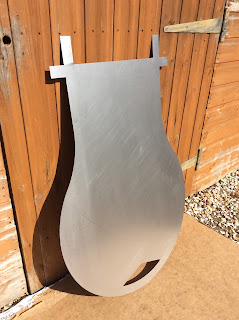 |
| 'Particle Psychology': steel mesh, leather, ash, wood, ceramic |
I went to Pound Arts in Corsham to document an installation piece of mine titled 'Particle Psychology'. Conveniently I had visited Devizes Archaeological Museum on the way and it prompted me to think about what I wanted to explore in this post. I am thinking about how sculpture can involve creating and using material vocabularies which sometimes develop over a long period of time. What gives a particular combination and use of materials resonance?
In the museum I was drawn in by the small but significant artefacts such as the
earliest known piece of glass found in Britain, the neolithic tattooing
equipment and the beautiful miniature axe pendants, which I would happily
wear if I could.
When making a sculpture you may be led by many factors other than the use value or structural properties of the materials. Your choice may be influenced by the associative potential of a material and its ability to conjure a particular era or context. By combining materials from contexts that are not usually associated, crafted and sculpted objects can lead us on new paths of association, providing something new in relation to the bank of objects we have already seen.
That is what I found myself thinking about when I made the piece. I was thinking how we mostly imagine invisible particles through the methods that are used to measure or protect from them - such as masks and filters. Or in the case of pollution through the effect over time that a substance has on the stone fronts of buildings. The steel mesh that I used to make the mask-like objects caught my attention because metal is included in what we think of as the 'neolithic' vocabulary of materials, alongside ceramics, rock and bone. However, the way the metal has been processed into tiny, tight, regular gridded mesh also speaks of industrial processing. I think I selected the material for that particular combination of affinity and dislocation.
It also has an amazing shimmery quality and is attractive to the eye but unpleasant to imagine covering the face. Sensory resonance can occur through heightened or combined forms of tactility, or the imagined tactility of the materials. Tactility and surface texture can also be closely related to notions of attraction and repulsion that we attach to materials; their qualities of roughness, smoothness, slipperiness or dryness.
In my next Sculptural Vocabulary post I'll reflect on notions of material hierarchy and value and how they impact on my thinking and practice as a sculptor.
 |
| 'Particle Psychology': steel mesh, leather, ash, wood, ceramic |
 |
| 'Particle Psychology': steel mesh, leather, ash, wood, ceramic |
 |
| 'Particle Psychology': steel mesh, leather, ash, wood, ceramic |
















































